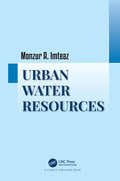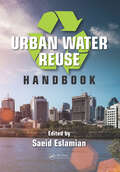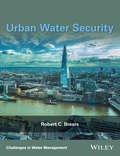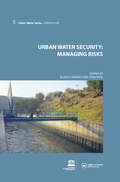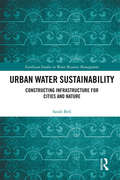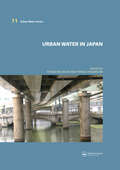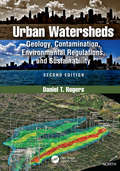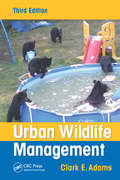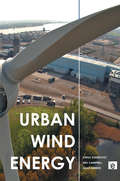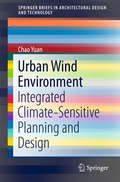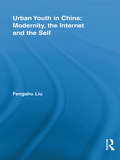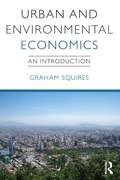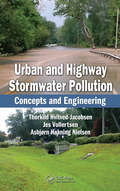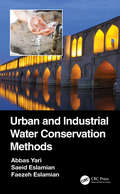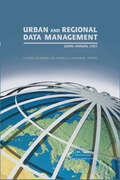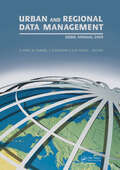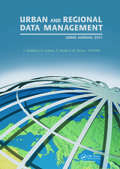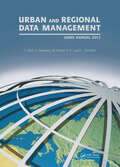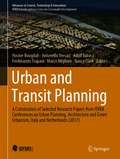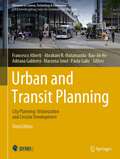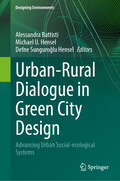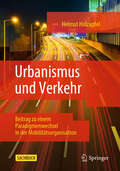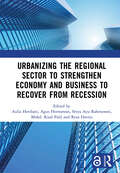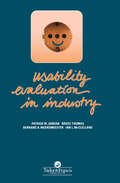- Table View
- List View
Urban Water Resources
by Monzur Alam ImteazEver increasing urbanization is impacting both the quantity and quality of urban water resources. These urban water resources and components of the water cycle are likely to be affected severely. To minimize the consequences on world water resources, the development of sustainable water resources management strategies is inevitable. An integrated urban water resources management strategy is the key to maintain sustainable water resources. A preliminary understanding of physio-chemical processes and analysis methodologies involved in each and every component of the urban water cycle is necessary. In the past these components have been investigated and published individually. With the view to aiding the development of integrated urban water resources management strategies, this book endeavors to present and explain the major urban water cycle components from a single holistic platform. The book presents the introduction, analysis and design methods of a wide range of urban water components i.e., rainfall, flood, drainage, water supply and waste water with the additions of sustainability practices in most of the components. Current "Hydrology" and "Hydraulics" books do not incorporate sustainability features and practices, while there are many books on general "Sustainability" without integrating sustainability concepts into typical engineering designs. The book starts with components and classifications of world water resources, then basic and detailed components of the hydrologic cycle, climate change and its impacts on hydrologic cycle, rainfall patterns and measurements, rainfall losses, derivations of design rainfalls, streamflow measurements, flood frequency analysis and probabilistic flood estimations, deterministic flood estimations, unit hydrograph, flood modelling, commercial modelling tools and use of Geographical Information System (GIS) for flood modelling, principles of open channel hydraulics, critical flow and flow classification indices, open channel flow profiles, uniform flow in open channel and open channel design, estimation of future population and domestic water demand, design of water supply systems, sustainable water supply system, water treatments, wastewater quantification, wastewater treatments, sustainable and decentralized wastewater treatment, stormwater drainage and urban drainage analysis, water footprint and water-energy nexus, features of water conservation, harvesting and recycling, components of sustainable urban design, stormwater treatment and integrated water management.
Urban Water Reuse Handbook
by Saeid EslamianExamining the current literature, research, and relevant case studies, presented by a team of international experts, the Urban Water Reuse Handbook discusses the pros and cons of water reuse and explores new and alternative methods for obtaining a sustainable water supply. The book defines water reuse guidelines, describes the historical and curren
Urban Water Security
by Robert C. BrearsIn the 21st Century, the world will see an unprecedented migration of people moving from rural to urban areas. With global demand for water projected to outstrip supply in the coming decades, cities will likely face water insecurity as a result of climate change and the various impacts of urbanisation. Traditionally, urban water managers have relied on large-scale, supply-side infrastructural projects to meet increased demands for water; however, these projects are environmentally, economically and politically costly. Urban Water Security argues that cities need to transition from supply-side to demand-side management to achieve urban water security. This book provides readers with a series of in-depth case studies of leading developed cities, of differing climates, incomes and lifestyles from around the world, that have used demand management tools to modify the attitudes and behaviour of water users in an attempt to achieve urban water security. Urban Water Security will be of particular interest to town and regional planners, water conservation managers and policymakers, international companies and organisations with large water footprints, environmental and water NGOs, researchers, graduate and undergraduate students. Robert C. Brears is the founder of Mitidaption, Mark and Focus, is Director on the International Board of the Indo Global Chamber of Commerce, Industries and Agriculture, and a Visiting Fellow (non-resident) at the Center for Conflict Studies at MIIS, Monterey, USA.
Urban Water Security: UNESCO-IHP
by Joan B. Rose Blanca Jimenez CisnerosUnderstanding the impacts of urbanization on the urban water cycle and managing the associated health risks demand adequate strategies and measures. Health risks associated with urban water systems and services include the microbiological and chemical contamination of urban waters and outbreak of water-borne diseases, mainly due to poor water and s
Urban Water Sustainability: Constructing Infrastructure for Cities and Nature (Earthscan Studies in Water Resource Management)
by Sarah BellThe provision of a safe and reliable water supply is a major challenge for the world's growing urban populations. This book investigates the implications of different developments in water technology and infrastructure for urban sustainability and the relationship between cities and nature. The book begins by outlining five frameworks for analysing water technologies and systems - sustainable development, ecological modernisation, socio-technical systems, political ecology and radical ecology. It then analyses in detail what the sustainability implications are of different technical developments in water systems, specifically: demand management, sanitation, urban drainage, water reuse and desalination. The main purpose of the book is to draw out the social, political and ethical implications of technical changes that are occurring in urban water systems around the world, with positive and negative impacts on sustainability. Distinguished from existing social science analysis due to its attention to the engineering details of the technology, this book will be of use to a wide audience, including students on water management courses, engineering students and researchers, urban geographers and planners interested in sustainability, infrastructure and critical ecology.
Urban Water in Japan (Urban Water Series)
by Fransje Hooimeijer Rutger De GraafWater control is essential to Japan, as more than half of its invested capital is concentrated in elevations under sea level and the majority of the island nation is exceptionally vulnerable to flooding. To avoid potential crisis, the Japanese have developed exceptionally innovative water management practices. Offering the unique perspective of Dut
Urban Watersheds: Geology, Contamination, Environmental Regulations, and Sustainability, Second Edition
by Daniel T. RogersUnderstanding that the natural world beneath our feet is the point at which civilization meets the natural world is critical to the success of restoration and prevention efforts to reduce contaminant impacts and improve the global environment because of one simple fact – contaminants do not respect country borders. Contaminants often begin their destructive journey immediately after being released and can affect the entire planet if the release is in just the right amount, at just the right location, and at just the right time. Taking an interdisciplinary approach, Urban Watersheds, Geology, Contamination, Environmental Regulations, and Sustainability, Second Edition presents more than 30 years of research and professional practice on urban watersheds from the fields of environmental geology, geochemistry, risk analysis, hydrology, and urban planning. The geological characteristics of urbanized watersheds along with the physical and chemical properties of their common contaminants are integrated to assess risk factors for soil, groundwater, and air. This new edition continues to examine the urban environment and the geology beneath urban areas, evaluates the contamination that affects watersheds in urban regions, and addresses redevelopment strategies. Features of the Second Edition: Examines contaminants and the successes of environmental regulation worldwide and highlights the areas that need improvement Describes several advances in investigation techniques in urban regions that now provide a huge leap forward in data collection, resolution, and accuracy Explains the importance of understanding the geological and hydrogeologic environments of urban and developed regions Provides new and enhanced methods presented as a sustainability model for assessing risks to human health and the environment from negative human-induced contaminant impacts Includes a new chapter that surveys how environmental regulations have been successful or have failed at protecting the air, water, and land in urban areas Suitable for use as a textbook and as a professional practice reference, the book includes case studies on successful and unsuccessful approaches to contaminant remediation as well as practical methods for environmental risk assessment. PowerPoint® presentations of selected portions of the book are available with qualifying course adoption. Daniel T. Rogers is currently the Director of Environmental Affairs at Amsted Industries Inc. in Chicago, Illinois. His writings address environmental geology, hydrogeology, geologic vulnerability and mapping, contaminant fate and transport, urban geology, environmental site investigations, contaminant risk, brownfield redevelopment, and sustainability. He has taught geology and environmental chemistry at Eastern Michigan University and the University of Michigan.
Urban Wildlife Management
by Clark E. AdamsWinner of the 2018 TWS Wildlife Publication Awards in the authored book category Urban development is one of the leading worldwide threats to conserving biodiversity. In the near future, wildlife management in urban landscapes will be a prominent issue for wildlife professionals. This new edition of Urban Wildlife Management continues the work of its predecessors by providing a comprehensive examination of the issues that increase the need for urban wildlife management, exploring the changing dynamics of the field while giving historical perspectives and looking at current trends and future directions. The book examines a range of topics on human interactions with wildlife in urbanized environments. It focuses not only on ecological matters but also on political, economic, and societal issues that must be addressed for successful management planning. This edition features an entirely new section on urban wildlife species, including chapters on urban communities, herpetofauna, birds, ungulates, mammals, carnivores, and feral and introduced species. The third edition features Five new chapters 12 updated chapters Four new case studies Seven new appendices and species profiles 90 new figures A comprehensive analysis of terrestrial vertebrate locations by state and urban observations Each chapter opens with a set of key concepts which are then examined in the following discussions. Suggested learning experiences to enhance knowledge conclude each chapter. The species profiles cover not only data about the animal concerned but also detail significant current management issues related to the species. An updated and expanded teaching tool, Urban Wildlife Management, Third Edition identifies the challenges and opportunities facing wildlife in urban communities as well as factors that promote or threaten their presence. It gives both students and professionals a solid grounding in the required fundamental ecological principles for understanding the effects of human-made environments on wildlife.
Urban Wind Energy
by Neil Campbell Sinisa Stankovic Alan HarriesEnergy security, rising energy prices (oil, gas, electricity), 'peak oil', environmental pollution, nuclear energy, climate change and sustainable living are hot topics across the globe. Meanwhile, abundant and perpetual wind resources offer opportunities, via recent technological developments, to provide part of the solution to address these key issues. The rapid growth of large-scale wind farm installations has now led to the generation of clean electricity for tens of millions of homes around the world. However, despite the potential to reduce the losses and costs associated with transmission and to use local wind acceleration techniques to improve energy yields, the potential for urban wind energy has yet to be realised. Although there is increasing public interest, the uptake of urban wind energy in suitable areas has been slow. This is in part due to a lack of understanding of key issues such as: available wind resources; technology integration; planning processes (include assessment of environmental impacts and public safety due to close proximity to people and property); energy consumption in buildings versus energy production from turbines; economics (including grants, subsidies, maintenance); and the effect of complex urban windscapes on performance. Urban Wind Energy attempts to illuminate these areas, addressing common concerns highlighting pitfalls, offering real world examples and providing a framework to assess viability in energy, environmental and economic terms. It is a comprehensive guide to urban wind energy for architects, engineers, planners, developers, investors, policy-makers, manufacturers and students as well as community organisations and home-owners interested in generating their own clean electricity.
Urban Wind Environment: Integrated Climate Sensitive Planning And Design (Springerbriefs In Architectural Design And Technology Ser.)
by Chao YuanIn the context of urbanization and compact urban living, conventional experience-based planning and design often cannot adequately address the serious environmental issues, such as thermal comfort and air quality. The ultimate goal of this book is to facilitate a paradigm shift from the conventional experience-based ways to a more scientific, evidence-based process of decision making in both urban planning and architectural design stage. This book introduces novel yet practical modelling and mapping methods, and provides scientific understandings of the urban typologies and wind environment from the urban to building scale through real examples and case studies. The tools provided in this book aid a systematic implementation of environmental information from urban planning to building design by making wind information more accessible to both urban planners and architects, and significantly increasing the impact of urban climate information on the practical urban planning and design. This book is a useful reference book to architectural postgraduates, design practitioners and planners, urban climate researchers, as well as policy makers for developing future livable and sustainable cities.
Urban Youth in China: Modernity, The Internet And The Self (Routledge Research in Information Technology and Society)
by Fengshu LiuFengshu Liu situates the lives of Chinese youth and the growth of the Internet against the backdrop of rapid and profound social transformation in China. In 2008, the total of Internet users in China had reached 253 million (in comparison with 22.5 million in 2001). Yet, despite rapid growth, the Internet in China is so far a predominantly urban-youth phenomenon, with young people under thirty (especially those under twenty-four), mostly members of the only-child generation, as the main group of the netizens’ population. As both youth and the Internet hold the potential to inflict, or at least contribute to, far-reaching economic, social, cultural, and political changes, this book fulfills a pressing need for a systematical investigation of how youth and the Internet are interacting with each other in a Chinese context. In so doing, Liu sheds light on what it means to be a Chinese today, how ‘Chineseness’ may be (re)constructed in the Internet Age, and what the implications of the emerging form of identity are for contemporary and future Chinese societies as well as the world.
Urban and Environmental Economics: An Introduction
by Graham SquiresThe importance of the built environment to environmental protection is well established, with strict environmental regulations now a feature of the working lives of planners, contractors, building designers, and quantity surveyors alike. Those new to, or preparing to join this industry must have an understanding of how their environmental responsibilities relate to their professional responsibilities in economic terms. Designed as an introductory textbook, Urban and Environmental Economics: An Introduction provides the background information from these disciplines to understand crucial tools and economic techniques. A broad range of theories of the natural and built environments and economics are explained, helping the reader develop a real understanding of the topics that influence this subject, such as: the history of economic thought on the built environment the economics of shared space in the built environment cost-benefit analysis and discounting macro-economic tools, measures, and policy sustainable development resource valuation. Illustrated throughout, and with lists of further reading in every chapter, this book is ideal for students at all levels who need to get to grips with the economics of the environment within a built environment context. Particularly useful to those studying planning, land economy, environmental management, or housing development.
Urban and Highway Stormwater Pollution: Concepts and Engineering
by Thorkild Hvitved-Jacobsen Jes Vollertsen Asbjorn Haaning NielsenAs the world population grows, already burgeoning cities are becoming taxed in every conceivable way. One topic that receives few headlines, but significantly impacts an area's quality of health and economic development is the challenge to maintain sustainable urban drainage (SUD). Poor drainage can hamper transportation, add to problems of polluti
Urban and Industrial Water Conservation Methods
by Saeid Eslamian Faezeh Eslamian Abbas YariUrban and Industrial Water Conservation Methods provides comprehensive and practical information regarding water use for various different sectors and describes the most suitable conservation devices and techniques to reduce water consumption in urban environments. It demonstrates how these conservation devices and best practices can greatly and quickly increase the efficiency of water use in both new and existing buildings. Features: Examines conservation devices and techniques across residential, commercial, and institutional sectors. Provides practical advice on implementing water conservation methods for users across various industries. Explains how to quickly improve water efficiency by using cost-effective water-saving devices and techniques. Includes relevant international case studies to reinforce the content. Written by practicing water conservation consultants for a wide audience, including municipality authorities and decision-makers, researchers, and students alike, Urban and Industrial Water Conservation Methods applies to residential, commercial, institutional, and industrial end users.
Urban and Regional Data Management: UDMS 2007 Annual
by Volker Coors Massimo RumorSpatial technologies like GIS, CAD, and spatial DBMS have proved their applicability and usability in almost every sector of urban development. Urban Planning Systems, Public Participation Systems, and others have been continuously developed and improved contributing to better decision making, communicating ideas between different actors as well as
Urban and Regional Data Management: UDMS 2009 Annual
by Sisi Zlatanova Elfriede Fendel Massimo Rumor Alenka KrekNatural and human activities change the environment we are living in and consequently impact the quality of life. Analysing these dynamics leads to a better understanding of urban change and facilitates urban development. Research related to the management of urban data has a long tradition. Through the years a variety of challenging research quest
Urban and Regional Data Management: UDMS Annual 2011
by Sisi Zlatanova Elfriede Fendel Hugo LedouxHuman activities as well as various natural phenomena change the environment and impact on the quality of life. Analysis of those dynamics is required for a better understanding of urban modifications, and to facilitate urban growth and development. Research related to the management of urban data has a long tradition. Through the years a variety o
Urban and Regional Data Management: UDMS Annual 2013
by Sisi Zlatanova Robert Laurini Massimo Rumor Claire EllulThe Urban Data Management Society has organised international symposia at various locations throughout Europe since 1971, and UDMS 2013 marks its second visit to London. From its outset, UDMS has highlighted changes and trends in urban data and urban data management. However, the rate of emergence of new data and new technologies has never been as
Urban and Transit Planning: A Culmination of Selected Research Papers from IEREK Conferences on Urban Planning, Architecture and Green Urbanism, Italy and Netherlands (2017) (Advances in Science, Technology & Innovation)
by Nancy Clark Hocine Bougdah Antonella Versaci Adolf Sotoca Ferdinando Trapani Marco MiglioreA volume of five parts, this book is a culmination of selected research papers from the second version of the international conferences on Urban Planning & Architectural Design for sustainable Development (UPADSD) and Urban Transit and Sustainable Networks (UTSN) of 2017 in Palermo and the first of the Resilient and Responsible Architecture and Urbanism Conference (RRAU) of 2018 in the Netherlands. This book, not only discusses environmental challenges of the world today, but also informs the reader of the new technologies, tools, and approaches used today for successful planning and development as well as new and upcoming ones. Chapters of this book provide in-depth debates on fields of environmental planning and management, transportation planning, renewable energy generation and sustainable urban land use. It addresses long-term issues as well as short-term issues of land use and transportation in different parts of the world in hopes of improving the quality of life. Topics within this book include: (1) Sustainability and the Built Environment (2) Urban and Environmental Planning (3) Sustainable Urban Land Use and Transportation (4) Energy Efficient Urban Areas & Renewable Energy Generation (5) Quality of Life & Environmental Management Systems. This book is a useful source for academics, researchers and practitioners seeking pioneering research in the field.
Urban and Transit Planning: City Planning: Urbanization and Circular Development (Advances in Science, Technology & Innovation)
by Francesco Alberti Abraham R. Matamanda Paola Gallo Adriana Galderisi Bao-Jie He Marzena SmolThis book represents a compilation of research in sustainable architecture and planning. Its main focus is offering strategies and solutions that help reducing of the negative impacts of buildings on the environment and emphasizing the suitable management of available resources. By tackling the topic of sustainability from a historical perspective and also as a vision for the future, the book in hands provides new horizons for engineers, urban planners and environmentalists interested in the optimization of resources, space development, and the ecosystem as a whole to address the complex unresolved problems our cities are facing. This book is a culmination of selected research papers from IEREK’s sixth edition of the International Conference on Urban Planning & Architectural Design for Sustainable Development (UPADSD) held online in collaboration with the University of Florence, Italy (2021) and the first edition of the International Conference on Circular Economy for Sustainable Development (CESD) held online in collaboration with the University of Salento, Lecce, Italy (2021).
Urban-Rural Dialogue in Green City Design: Advancing Urban Social-ecological Systems (Designing Environments)
by Michael U. Hensel Alessandra Battisti Defne Sunguroğlu HenselUrbanization and construction are primary drivers of land cover and land use change, climate change and environmental degradation. Sustainable development seeks to counteract the negative impact of cities and urbanization. Shifting away from the still prevailing human-nature dialectic, social-ecological systems view humans as part of nature, thereby linking biophysical and social factors into a coherent system across spatial, temporal and functional scales. This approach and related complex and adaptive approaches and systems enable a new take on sustainable urban development and in particular green cities. The proposed book will focus on different aspects of advancing urban social-ecological systems with particular emphasis on the Urban-Rural Dialogue in Green City Design. The chapters will outline novel approaches to thinking and designing green cities, urban form as urban landform, integration of architectures and their settings, novel hybrid land use and related hybrid architectural typologies, multi-stakeholder and multi-species approaches. This will include a range of topics including green urban land use, urban ecosystem development and support, urban agriculture and food production, urban farming and gardening, and human health and well-being. Given the existing strong movement and research in this field in Italy, the book will concentrate on ground-breaking approaches and research from this region. A list of recognized authors will present approaches and discussions centering around the above-listed thematic foci concerning green cities planning, design, governance and ultimately aspects of living in green cities. The presented themes and approaches are also of more general fundamental relevance for urban contexts in other regions with comparable climate and environmental conditions. Therefore, we anticipate that the book will become a course book for many courses taught at universities worldwide, as well as a book for researchers and practitioners that wish to inform and prepare themselves for what is to come in terms of novel green city design.
Urbanismus und Verkehr: Beitrag zu einem Paradigmenwechsel in der Mobilitätsorganisation
by Helmut HolzapfelDas Sachbuch, jetzt in der dritten erneut überarbeiteten Auflage beinahe schon ein Klassiker der interdisziplinär begriffenen Verkehrs- und Stadtforschung, ist aktueller denn je. Es vermittelt auf kluge Weise Kenntnisse, der historischen und sozio-kulturellen Wurzeln einer einseitig vom Automobil dominierten Perspektive der Verkehrsplanung. Es zeigt die Entwicklung einer von fossiler Energie getriebenen Planung, die seit Jahrzehnten die sozialen und ökologischen Systeme überfordert, und vermittelt darüber hinaus Lösungsansätze, für eine menschengerechtere Stadt- und Verkehrsorganisation, die nicht ihr Heil in der Distanzüberwindung findet, sondern Qualität in der Nähe. Das völlig neu konzipierte Schlusskapitel zeigt eindringlich, dass der Wandel in Transport und Verkehr, oft als Verkehrswende bezeichnet, ohne einen radikalen Paradigmenwechsel in Verhalten, Städtebau und Mobilitätsorganisation nicht gelingen kann. Die 3. Auflage wird mit einem Vorwort von Jens Hilgenberg, Bund für Umwelt und Naturschutz Deutschland e.V. (BUND), eingeleitet.
Urbanizing the Regional Sector to Strengthen Economy and Business to Recover from Recession: Proceedings of the 5th International Research Conference on Economics and Business (IRCEB 2021), Malang, Indonesia, 10–11 November 2021
by Aulia Herdiani Agus Hermawan Setya Ayu Rahmawati Mohd. Rizal Palil Reza HaviesThis pandemic does not only affect health aspects but also economic aspects. The world today faces a recession resulting from the covid-19 pandemic. Indonesia's economy continues to lead to a recovery, although not very significant. The current government continues to make various recovery efforts. One of the flagship programs includes encouraging and strengthening support for social protection and increasing the purchasing power of households as well as various business sectors, including small and medium-sized micro enterprises (MSMEs). This condition urges the world to create new breakthroughs to rise from this adversity. Academicians and practitioners need to work together to find the necessary solutions and developments. Surely, it will contribute to solve the problems in society by interdisciplinary cooperation. This collaboration will create innovations in science and technology especially business and economic field. This book includes in-depth discussions between academicians and practitioners, especially on how to strengthen the regional sectors to be the strong pillars of the country’s economy. Interestingly, various methods are used to observe the problems, to explore the solutions, and to develop the innovation. This book will be of interest to students, scholars, and practitioners of social empowerment, governance, and other related stakeholders.The Open Access version of this book, available at http://www.taylorfrancis.com, has been made available under a Creative Commons [Attribution-Non Commercial-No Derivatives (CC-BY-NC-ND)] 4.0 license. Funded by State University of Malang.
Ursprünge aller Energiequellen: Alle nutzbare Energie kommt aus atomaren und kernphysikalischen Prozessen (essentials)
by Wolfgang OsterhageWolfgang Osterhage vollzieht die ,,Rückführung" der Energie auf die ursprünglichen Quellen, denn auch die heute als ,,alternativ" apostrophierten Energieformen haben ihre Ursprünge in kosmischen und mikrokosmischen Prozessen, die sich auf unterschiedliche Weise bei uns auf der Erde manifestieren. Zum Verständnis stellt der Autor dazu die Grundlagen der Atom- und Kernphysik in allgemein verständlicher Form vor.
Usability Evaluation In Industry
by Bernard A. Weerdmeester Bruce Thomas Patrick W. Jordan Ian L. McClellandThis book provides a variety of answers in its description and discussion of new, sometimes radical approaches to `usability evaluation', now an increasingly common business tool. It contains new thinking of the subject of usability evaluation in industry. Contributions come from those involved in the practice of industry-based usability evaluation
